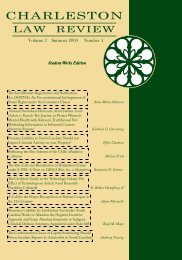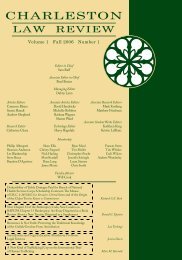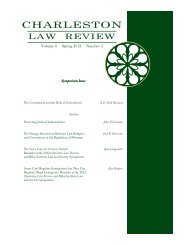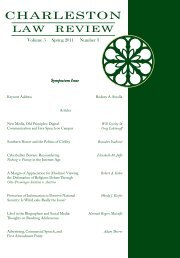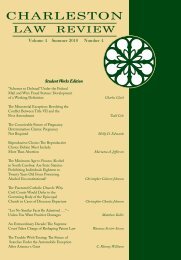Volume 5 Winter 2011 Number 2 - Charleston Law Review
Volume 5 Winter 2011 Number 2 - Charleston Law Review
Volume 5 Winter 2011 Number 2 - Charleston Law Review
Create successful ePaper yourself
Turn your PDF publications into a flip-book with our unique Google optimized e-Paper software.
SCHULZE FINAL.doc1/20/<strong>2011</strong> 6:14PM<strong>2011</strong>] <strong>Law</strong> School Academic SupportFor instance, Professors Sheldon and Krieger establishedthat, although law students enter law school with levels ofdepression, anxiety, and drug and alcohol abuse similar to thosein other fields of graduate study, the first year of law schoolchanges this. 91 First-year law students’ levels of depression,anxiety, and substance abuse increase at a rate well beyond thatof those in other graduate studies. 92 Sheldon and Krieger’sanalyses “showed that participants experienced large reductionsin positive affect, life satisfaction, and overall [subjective wellbeing],and large increases in negative affect, depression, andphysical symptoms” in the first year of law school. 93 Unlike otherresearchers, Sheldon and Krieger did not attribute the causationof these psychological manifestations to the Socratic Methodalone. Instead, they traced these problems to a far wider array ofnegative factors in the law school education: (1) the lack offormative assessment, feedback, or both; (2) competition foracademic superiority due to rigidly imposed grading curves; (3)purely hierarchical markers of worth; (4) teaching methods thatare isolating; and (5) average GPAs far lower thanundergraduate norms. 94 The study found that even while thestudents’ mental health worsened, students moved away fromintrinsic motivation—making oneself happy—toward extrinsicmotivation—proving oneself to others. 95This shift and its correlated effects upon mental health seemto dovetail with the negative aspects of legal education.Humanizing the law school environment would, obviously,directly affect intrinsic and extrinsic motivation and help tooffset the negative elements of a law school environment.91. Id. at 262.92. Id.93. Id. at 272.94. Id. at 262, 281. One might argue that the fifth factor is a function ofgrade inflation at the undergraduate levels. As undergraduate institutionsfight for better scores in the all-important U.S. News & World Report rankingsby making student-consumers happy with high grades, rigorousness and actuallearning decline. <strong>Law</strong> schools will soon catch on to this trend, as already we seeevidence of grade inflation at the law school level. Catherine Rampell, In <strong>Law</strong>Schools, Grades Go Up, Just like That, N.Y. TIMES (June 21, 2010),http://www.nytimes.com/2010/06/22/business/22law.html.95. Sheldon & Krieger, supra note 90, at 281.297



